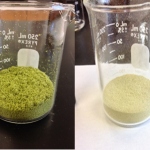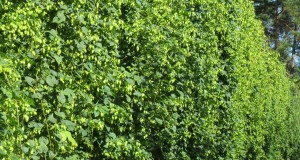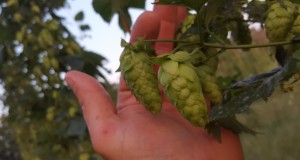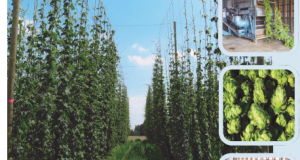By: Evan Elford – New Crop Specialist | OMAF/MRA | ONspecialtycrops | May 2014
Information on the analytical components of hops such as alpha acids (Cohumulone and Adhumulone + Humulone) and beta acids (Colupulone and Adlupulone + Lupulone) are an important part of marketing hops to brewers who rely on these figures when adjusting brewing recipes. Many cultivars have previously established alpha and beta acid values with a range of approximately ± 2% deviation from that value. However, most of the historical values are derived from hops grown in the Pacific Northwest (PNW) of the United States. One of the objectives within the New Directions research trial at the University of Guelph is to evaluate the components of locally grown hops to better understand analytical values and ranges of specific hop cultivars under Ontario growing conditions.
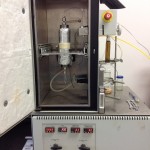
Figure1: CO2 extractor at Loyalist College used to analyse hops from the New Directions research project. Photo courtesy of Loyalist College.
Loyalist College, a research partner on the New Directions project, analysed 6 of the 10 cultivars grown at the Simcoe Research Station during the 2013 growing season. The other four cultivars did not produce enough cone material in this establishment year for analysis. Growing conditions and harvest methods at the Simcoe site in 2013 are provided in Appendix 1. Supercritical CO2 extraction was used on each of the hop samples (Figure 1 and 2) followed by High Performance Liquid Chromotography (HPLC) to identify and quantify each component. Protocols used by Loyalist College were derived from the American Society of Brewing Chemists (ASBC) for extraction of alpha and beta acids. Alpha and beta analytical standards used for calibration were also obtained from the ASBC.
Analytical results of alpha and beta acids from the 2013 harvest and expected ranges derived from the ten year USDA Hop Cultivar Index and Yakima Chief Inc. Varietal Guide are summarised in Table 1.
Table 1 (adapted from Bakker, C., et al., 2014): Alpha and beta acid content of hop cones from various hop cultivars grown at the Simcoe Research Station, Simcoe, Ontario, 2013.
|
Cultivar |
Alpha Acid Content (%) |
Beta Acid Content (%) |
|||
|
Results from trial1 |
Expected range2 |
Results from trial1 |
Expected range2 |
||
|
Zeus |
13.9 a3 |
14.6-18.3 |
4.3 c |
4.8-5.5 |
|
|
Chinook |
11.5 b |
13.9-15.3 |
3.0 d |
3.6-4.5 |
|
|
Galena |
8.8 c |
8.0-14.9 |
6.4 a |
4.6-9.0 |
|
|
Bertwell |
5.5 d |
N/A |
5.1 b |
N/A |
|
|
Cascade |
4.1 e |
5.1-8.5 |
4.0 c |
4.0-6.6 |
|
|
Crystal |
3.9 e |
2.8-4.4 |
5.0 b |
5.8-7.0 |
|
1Alpha and beta acid content was determined using HPLC at Loyalist College.
2Ten year range from the USDA Hop Cultivar Index (http://www.ars.usda.gov/pandp/docs.htm?docid=14772), values for cv. Zeus from the Yakima Chief Inc. Hop Varietal Guide.
3 Numbers in a column followed by a different letter were significantly different at P = 0.05, Fisher’s Protected LSD.
The majority of cultivars fell within the USDA 10 year range except for Chinook which was slightly lower in both alpha and beta acid content. Analysis of hop components will continue in the 2014 and 2015 growing seasons. The New Directions hop project team also plans to include samples from Ontario growers in the coming years to better understand the expected ranges found in hops grown across the province.
Acknowledgements
Continued thanks to all project partners and funders: OMAF and MRA New Directions Research Program and field staff; University of Guelph; Loyalist College; Ontario Craft Brewers; Erie Innovation and Commercialization; individual Ontario hop growers (prior to formation of the OHGA).
References
Bakker, C. 1, Elford E.M.A. 2, and McDondald M.R.1 (2014). Hop Cultivar Evaluation. 1University of Guelph, Dept. of Plant Agriculture, Simcoe Research Station, 2Ontario Ministry of Agriculture and Food and the Ministry of Rural Affairs, Simcoe Resource Centre, Unpublished.
Goulah, A. and Kramp, K. (2014). Hops CO2 Extration Report. Loyalist College, Unpublished.
Appendix 1
Simcoe Growing Conditions and Harvest Methods, 2013 (from Bakker, C., et al. 2014):
All plants in each plot were harvested by hand when cones reached a target dry matter of 20-25%. Harvest dates were: Cascade (27, 28 Aug), Chinook (17 Sept), Galena (17, 18 Sept), Bertwell (18, 19, 20 Sept), Crystal (20 Sept), and Zeus (23 Sept). Cones were counted, weighed and dried for 3-5 days in a greenhouse under shade to reach a target moisture content of 8%. Weight was recorded again after drying was complete. Cones were then vacuum sealed and stored in a freezer until analysis of alpha acid content could be done. Alpha and beta acid content was determined using CO2 extraction and HPLC at Loyalist College. Compared to the averaged previous 10 years, average air temperatures in 2013 were near average for July (21.5°C), below average for June (18.3°C), August (19.9°C) September (15.8°C) and above average for May (15.1°C) and October (11.1°C). Monthly average temperatures for the 10 previous years were (°C): May 13.9, June 19.3, July 21.8, August 20.7, September 17.2, October 10.3. Monthly total rainfall was below average in July (53 mm) and above average in May (99 mm), June (189 mm), August (87 mm), September (110 mm) and October (145 mm). Average monthly rainfall for the previous 10 years was (mm): May 88, June 72, July 83, August 82, September 86 and October 70.
To read the original article, click here.
 Ontario Hop Growers' Association The OHGA is a not-for-profit association of hop growers, families and enthusiasts who are interested in supporting the growth of the hop industry in Ontario.
Ontario Hop Growers' Association The OHGA is a not-for-profit association of hop growers, families and enthusiasts who are interested in supporting the growth of the hop industry in Ontario.
